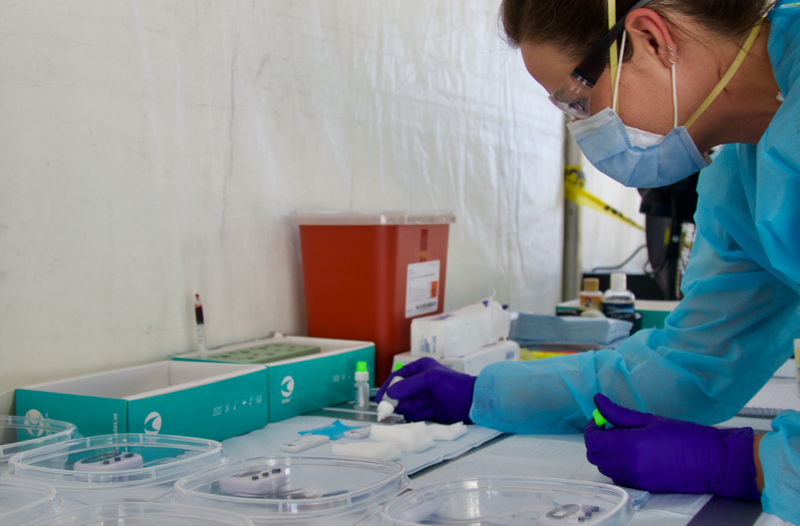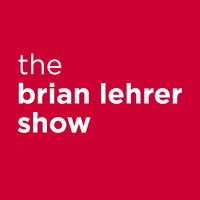30 Issues: The Future of COVID-19 Testing

( Sgt. Leia Tascarini/U.S. National Guard )
[music]
Brian Lehrer: Brian Lehrer on WNYC. Now, we continue our 30 issues in 30 days election series, we're up to issue 24, testing and tracing during the COVID-19 pandemic. We are in a stretch of eight days in a row on issues related to the pandemic. Joining me now to talk about how testing works and is deployed and how it could become more central to recovery and reopening in the United States is Dr. Ashish Jha, physician, health policy researcher, and dean of the Brown University School of Public Health. Now, since he is non-political, he will tell us mostly what might be possible for whoever is elected. Welcome back to WNYC, Dr. Jha, thanks so much for doing this.
Dr. Ashish Jha: Thank you for having me back, Brian.
Brian: In the current debate over a new COVID relief bill, one big sticking point is funding for what the Democrats call a national test and trace corps. Here's a quote from Speaker Pelosi from this month. She said, "We cannot safely reopen schools, the economy and our communities until we crushed the virus with the science-based national plan for testing, tracing, treatment, and isolation and for the equitable and ethical distribution of a safe and effective vaccine once developed." I guess my question is for you, when it comes to testing, how different would that be from what we have now?
Dr. Jha: Many of us have been calling for a national plan, really, since March and we haven't had one. It's been 50 different plant. Every state has their own approach and New York actually is doing quite a good job. I think this is one where Governor Cuomo has been really extraordinary in leadership, but the bottom line is it's still not enough. Some sort of a national plan would be helpful.
At this point, what many of us are pushing for since I don't think we're going to get a national plan soon is resources out to states and groups of states coming together. All of it, Brian, is really with two goals. One is to make sure there's plenty of money to ramp up testing and have more testing widely available. Second, to be able to provide guidance to states on how to deploy that testing so we can keep people safe as they try to go back to school and work.
Brian: Back in May of this year, by contrast, President Trump was very skeptical about testing. Here's a very short clip.
President Trump: When you test, you have a case. When you test, you find something is wrong with people. If we didn't do any testing, we would have very few cases.
Brian: I know, and he keeps saying things like that to this day, but he's right, perhaps, the tests don't equal seriousness. What do we learn by massive testing?
Dr. Jha: What the president says sounds right until you think about it. Then the moment you think about it, you realize, actually, there's a problem there. The issue is this. When you test people and you find that they are infected, the biggest thing you can do and the most important reason to test people is then you can isolate them from then infecting others. That's why you test people.
You test people to figure out who's infected so they don't go around infecting other people. We think there's a 5 to 10-day period where people are infectious. If you can find them early in that 5 to 10-day period, they're not going to infect other people. Presumably that people who test positive will then isolate and we do have to help people isolate. This is not just about testing itself. It's about what comes as a result of testing.
We know this bogus argument that testing is what leads to cases is not true because New York is doing more testing than almost any state in the country. They have one of the lowest number of cases on a per capita basis. Part of their success has been the phenomenal testing program and in fact, states that have very little testing are seeing lots of cases, lots of hospitalizations, and lots of deaths so it's really quite the opposite of what the president says.
Brian: You mentioned New York and I want to raise something that Governor Cuomo said yesterday as a possible vision of the future of testing. He was talking about the issue of people coming back to New York, from states that are on New York's quarantine list. He proposed, instead of the quarantine system that we have now where everybody's supposed to quarantine theoretically for two weeks when they enter the state from a high-case state, he proposed a rapid testing regime. This is just eight seconds of Governor Cuomo.
Governor Cuomo: There's new testing technology. There are rapid tests. Is there a better, smarter way to handle a quarantine?
Brian: Do you see expanding rapid testing? Maybe you could take a minute and tell people what that is and what the science on the horizon is, but do you see it as a potential big key to both tamping down number of people who get sick and reopening society?
Dr. Jha: Absolutely. Let's talk about rapid testing. There are a couple of different types. The most common one that's out there is what's called antigen testing. There are tests, there are three or four now in the marketplace, they've been available since May. We just haven't quite ramped up production of them and they give you a results in about 15 minutes. Basically, what they do is there's a little swab in the throat or in the nose and they're looking for proteins on the virus to see if you have those proteins, then you're going to be a positive.
The downside of these antigen tests is that they'll miss a certain proportion of people, but they tend to be very good for people who are infectious. Remember I told you that there's a 5 to 10-day period where people are really infectious. During that time period, it tends to be very good. It'll miss some people laid in disease who are no longer infectious, but my take is that's probably okay. It's not as big a deal.
Ultimately, if we got to a point where we had widespread antigen testing available in schools, in workplaces when people came back from high-case load areas, it would make an enormous difference. Now, if somebody comes back from North Dakota right now, maybe one negative antigen test isn't enough to end their quarantine, but you can imagine one of those and then maybe five days later, a second and it would do it. These tests costs $5 to $10 each. We're not talking about something that's hugely expensive. They should be widely available, Brian, and they're not widely available because we have not had a federal government that has really leaned into making these tests widely available.
Brian: Let me go even further with this rapid testing scenario, which is still going to be new to some of our listeners. I was just talking last night to a friend of mine with connections to the music business. He told me that he sees a rapid test system, once they can really ramp it up, as a potential way to reopen concert halls, Broadway theaters which we know are now close until at least next June, and other entertainment venues, essentially staff could make the audience show a negative rapid test result taken in the last day or so at the door.
I guess there are ways that they could determine with some kind of ID system that those are real.
I see that Saturday Night Live has recently done something like this for its limited studio audience, as an example. Do you see anything like that as feasible as a way to reopen Broadway, music venues and things like that here in New York or elsewhere?
Dr. Jha: Absolutely. Again, the price point I told you of like a $5 test means that it's pretty affordable in lots of contexts. Airlines are starting to do this, Lufthansa started doing this, of course, for their business and first-class passengers. Initially, again, actually, that gets us to a point where what we're doing is creating systems of more and more haves and have-nots, which we can talk more about, but the bottom line is what your friend was saying is completely right.
I envision a world, again, if we can get the right leadership because the market will get there, it's just going to take too long. With the right kind of federal partnership, I envision widespread availability of these tests. You could show up to the Broadway show 15 minutes early and do the test if you haven't gotten it. There are lots of ways of doing this, where it would allow for restaurants, bars, and lots of places to be able to create a layer of safety that will make everybody much more comfortable patronizing those places.
Brian: Is there a plan? You tell me if this veers too close to politics for you as dean of the Brown School of Public Health, which is obviously an apolitical institution. Is there a Biden plan to get us to that and no Trump plan? Is there some kind of plan that each side has or is neither side getting that specific?
Dr. Jha: First of all, I don't speak for my institution. I speak for myself and I will happily share what I know. What I know is that both sides would argue they have a plan. The Trump side, of course, has been in office for the last eight months and what they have done is they've encouraged people to build out more some of these tests, they've put in some resources, but my feeling is it's been wholly inadequate, it's been completely uninspiring, and it hasn't gotten us where we need to be.
Again, some of these tests started coming online in May. We're in mid to late October. Why we have not applied the full power and resources of the federal government? It would be hugely economically beneficial. It would more than pay for itself and yet, we haven't done it. The Biden team has been very clear that they are very interested in ramping up testing and making it widely available.
They understand that this is not a three or a six-months problem, that this virus is going to be with us for years, and we're going to want ubiquitous cheap testing for many many years, and they've been pretty clear that they're going to make the investments necessary. The Trump team has just not done it so far and that's, to me, not a partisan issue. It's just the facts on the ground.
Brian: The Washington Post recently reported that the Trump administration has not spent $9 billion in funding for COVID-19 testing that they actually could allocate to spend that's been approved by Congress because of opposition from this new prominent advisor on the White House Coronavirus Task Force, Dr. Scott Atlas. Again, maybe this is too political, but are you aware of that money being withheld and what it is that they would be spending it on?
Dr. Jha: This has been a source of ongoing frustration because I spend a lot of time talking to states to governors, to health departments, health secretaries, and states are bleeding money on this and need federal dollars. That $9 billion remain unspent, there has been a bill at Congress to give states a lot more resources so they can do this stuff. That money just hasn't flown to state-- Gotten to states as it needs to. In terms of Dr. Atlas, I'm sure he's a well-intentioned guy. He fundamentally misunderstands how infectious diseases work. He really believes that if you don't test people, somehow, the virus will just disappear.
It turns out that, and he makes a point that while we don't want to test young people because they don't get sick, some young people do get sick, of course, Brian, but the bigger issue is young people don't live on an island. They interact with older people. When young people get sick and aren't identified as being sick because there's no testing, they infect older people who then get sick and die. Somehow, Dr. Atlas has managed to convince people in the White House that young people live on an island, they don't affect older people and therefore, we shouldn't be testing.
It's really harmful and it is making all of this stuff much, much harder. Actually, it's harming states' ability to do the right thing because they're not getting the federal dollars because the White House is not being supportive.
Brian: In a way, the reluctance to test on a widespread basis is the most surprising aspect of Dr. Atlas, his philosophy to me. Okay. If he wants to pursue herd immunity, maximum reopening of society, let the young people get sick and try to protect the older people in the otherwise more vulnerable people, okay, that's his minority view and the White House is buying it at the moment, but I couldn't understand why part of that is to discourage widespread testing to see who is getting the virus. Do you even get it?
Dr. Jha: Yes. First of all, I think all of us want as much of our economy open as possible. We want kids back in school. The goal isn't where we disagree. It's the strategy for getting there. He believes, and again, I'm reading his tweets and his comments, he believes that if you identify young people as being infected, somehow, that will psychologically prevent people from engaging in economic activity, that like you ended up shutting down schools if you have large outbreaks in schools.
We should just let large outbreaks run and not test, not try to identify, if there was a school with hundreds of kids getting infected, let's not learn that, let's not identify that because that will lead us to close down the school and he just wants the virus to run among young people. The problem again is young people, kids in school, guess what, they go home. We don't want large outbreaks in schools. We don't want large outbreaks in colleges. We don't want large outbreaks in workplaces, but he thinks it's actually a good thing because that's how we're going to get to herd immunity and he thinks testing will slow us down towards getting much of America infected.
Brian: Bottom line, you've laid out here an even more stark difference between the Biden vision and the Trump vision. Then I think I even realized existed when it comes to a particular topic today which is testing. That's the Biden is going to try to ramp up testing to a very, very large degree and try to push forward these rapid tests we were talking about earlier and the Trump administration, as a matter of policy, is really trying to discourage testing.
Dr. Jha: Look, I'm not affiliated with either campaign. I've spoken, I speak to people all the time. I've spoken and read the reports from the Biden campaign. I've obviously spoken to people in the Trump White House. The story here is very, very clear. Everything I've read and seen from the Biden campaign suggests a strategy for making widespread testing available to all Americans and really using the power of the federal government to do that.
On the Trump side, there's mixed messaging because there are people, like obviously, Dr. Fauci, he's part of the White House task force, Dr. Birx, other people who are arguing for more testing, but at this moment, the White House policy really seems to be driven by Dr. Atlas who believes that we shouldn't have to be wearing masks, that we shouldn't be doing testing. We should sort of just see how it goes. Obviously, it's hard to contrast two strategies more starkly than that.
Brian: That's our 30 issues in 30 days segment, issue 24, testing, testing, one, two, three. Tomorrow, we continue with our stretch of eight days in a row on pandemic-related issues and the presidential race tomorrow. It's how to develop and distribute vaccines. For now, we thank Dr. Ashish Jha, physician, health policy researcher, and dean of the Brown University School of public health. Dr. Jha, thank you so much.
Dr. Jha: Thank you, Brian.
Copyright © 2020 New York Public Radio. All rights reserved. Visit our website terms of use at www.wnyc.org for further information.
New York Public Radio transcripts are created on a rush deadline, often by contractors. This text may not be in its final form and may be updated or revised in the future. Accuracy and availability may vary. The authoritative record of New York Public Radio’s programming is the audio record.

